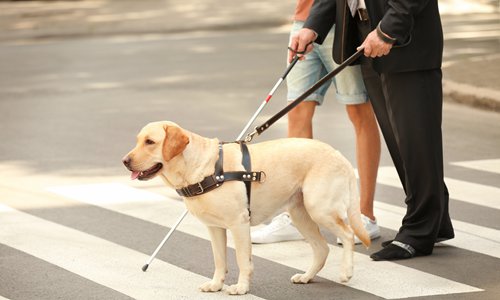HOME >> OPINION
Much care needed for the visually impaired in China
By Wendy Min Source:Global Times Published: 2019/8/30 19:38:40

Photo: IC
After a short taxi ride through Beijing, I noticed that the city is covered with Braille pavements. Yet, those who are visually impaired are rather invisible and I don't think they would have an easy time navigating those walkways and pavements. Not all are in prime condition, there are holes, many are either too close to the edge of the street and bus stands or obstructed by trees and other civic and urban paraphernalia.
The most frustrating of them is seeing pavements being obstructed by bikes, cars and poles. In addition, some traffic lights have short-time intervals which makes it difficult for many - the challenged, mothers with babies, and the old and infirm - to cross the street. Sure - to a degree, the physically and visually impaired are an invisible group in China. However, seeing the mismatch between infrastructure and their needs is a shame and a reminder that more needs to be done. In the end, such facilities should never be there just for show. Poor planning and a can't-care-less attitude of citizens does little to improve the situation.
When speaking about the visually impaired, perhaps the one thing that still perplexes me is why there are so few guide dogs and lack of respect and understanding for the important role they play for this group of people with special needs. Seeing guide dogs take public transport or flights or the subway train is a common thing in the West.
My friend, Chen Yang, an advocate for the visually impaired and her former guide dog Jenny, were denied entry into the subway several times because the guide dog was seen as a pet. 10 year-old Jenny was the 18th graduate from the guide dog training center located in Dalian and established in 2006. In China, the main issue in addition to lack of awareness is the fact that the demand far exceeds the supply of guide dogs. In China there are more than 2,000 pandas and a little over 200 guide dogs.
The guide dog program was first established in China over a decade ago - timed well when the country hosted the 2008 Olympics and Paralympics. Tens of thousands of blind people apply for guide dogs. However, due to funding, supply (due to cost, selection and training time), hukou allocation and also the waiting time, many people miss out on getting a guide dog. Chen Yang told me that it took nearly two years for Jenny to be properly trained at Dalian. The cost could be as much as 100,000 yuan ($13,987) so funding must be continued. There needs to be more trainers and training centers as well as more supplies of Golden Retrievers and Labradors instead of other more cute but useless breeds. Above all, guide dogs deserve respect for their hard-work, intelligence, calmness, obedience and the services they render.
Chinese government data says there are more than 12 million visually impaired individuals living in the country or about 18 percent of the world's blind. Yet when less than 10 percent of public libraries with books for the visually impaired, pavements are being obstructed and the wait for a guide dog can be as long as four to five years, there is still much to be done. With that being said, there has been research and much initiative in helping the visually impaired. From one Tsinghua group designing a system which allows the visually impaired to handle visual information to finding ways to make tactile images readable to having Braille libraries pop up in Kunming and more voices in support of guide dogs, more must be done and changes must continue to ensure that every citizen is properly cared for. This is what every nation should strive for.
The author is a freelance writer. She was born in China, raised in Australia, educated in China, Australia and France. opinion@globaltimes.com.cn
Posted in: VIEWPOINT